
Sir Isaac Newton
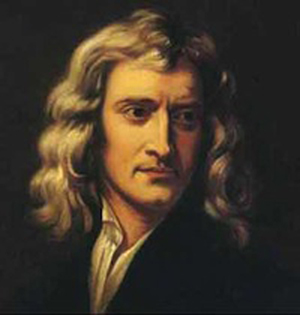
0ver 200 years before Einstein the laws of motion were originated by Sir Isaac Newton. His three famous laws of motion and his outstanding law of gravity are:
- An object at rest tends to stay at rest and an object in uniform motion tends to stay in uniform motion unless acted upon by a net external force.
- An applied force, F, on an object equals its mass times its acceleration: F = m x a.
- For every action there is an equal and opposite reaction.
- The gravitational force between two objects is proportional to their masses and is inversely proportional to the distance between the centers of the two objects squared: F = G x [m1 x m2] / d^2 where G is the gravitational constant.
In addition to his contributions in physics which were many besides the above, he shared credit with Gottfried Leibniz for the development of differential and integral calculus. Newton was born in 1642 and died of mercury poisoning at 86 in 1727. Most of his significant contributions came between the years of 1665 and 1690. His theories dominated physics until 1905. However in all his work, space and time were always constants, never variables. Top
James Clerk Maxwell

James Maxwell was a Scottish physicist and mathematician. Maxwell's four equations of electro-magnetism unified previous knowledge of electricity, magnetism and light into one theory that postulated that all of these phenomenon were based on electro-magnetic fields. Maxwell showed that electric and magnetic fields travel through space in the form of waves. He was the first to point out that light was just another electro-magnetic wave traveling at a fixed speed. All previous laws and equations of these disciplines became just simplified cases of Maxwell's equations. Maxwell's achievements are called the "second great unification in physics" after the first one performed by Sir Isaac Newton.
Maxwell was born in 1831 just over 100 years after the death of Isaac Newton. Maxwell attended Edinburgh and Cambridge Universities. He became a professor at Aberdeen University in Scotland in 1856 at age 25, 15 years younger than any other professor. In 1871 he became the first Cavendish Professor of Physics back at Cambridge University. He died of cancer at the young age of 48 in 1879. During Maxwell's time it was known that light traveled about 300,000 meters per second (186,000 miles per second). Maxwell's equations predicted that all electro-magnetic waves of light would travel at the same fixed speed. But a fixed speed relative to what? Just as waves travel through water, it seemed there had to be a medium that light waves traveled through. It was believed at that time that throughout space everywhere there was an invisible medium called the "either". The speed of light therefore was relative to the "either". Top
Albert Einstein
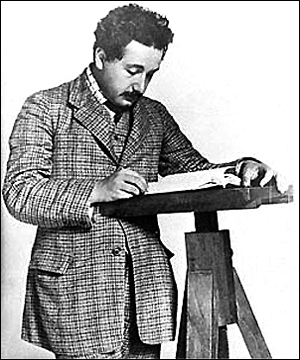
It is impossible to talk about relativity without discussing Albert Einstein. Although Newton's Laws adequately explained most physical phenomenon, there were a few contradictions that bothered some physicists. In 1887 Michelson and Morley of Case Western University in Ohio carried out a carefully constructed experiment that proved to everyone's surprise that the speed of light was always the same no matter what the speed or direction of the observer. This could not be explained by Newtonian principles. Also, the orbit of the planet Mercury always varied somewhat from very detailed Newtonian calculations.
However, Albert Einstein was not particularly motivated by these contradictions. Einstein came at the subject of relativity and the speed of light from a purely theoretical point of view expanding on the earlier work of Maxwell, who showed that the speed all electro-magnetic waves, including light, was a constant.
Albert Einstein was born in 1879 in Germany. At the age of 26 (pictured at the left) he was employed full time at the Patent Office in Zurich, Switzerland. On his own time after hours, he published four incredible papers in his fabulous year of 1905 which included Special Relativity and the Equivalence of Matter and Energy. He also completed his PhD at the University Of Zurich in the same year. In 1909 he quit the Patent Office and taught at the University of Zurich where he worked until 1914 when he returned to Germany. In 1915 he published his papers on General Relativity and the Equivalence Principle which were received with a great deal of skepticism. According to General Relativity, the gravitational attraction between masses results not from some hidden force but from the warping of space and time by those masses.
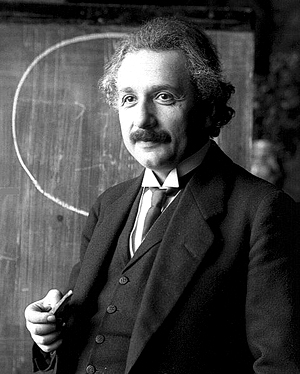
He also said there was no such thing as "either". And, he predicted from his theory that light from distant stars would be bent by the sun. This last item was very controversial because light had no mass and according to Newton only objects with mass are attracted to one another. Many then current scientists did not subscribe to some of the things this new theory predicted.
However in 1919 a renown team of scientists showed that light did in fact bend coming around the sun (see Bending Of Light below). This was amplified in the everyday press all over the world and Einstein soon became a household name. In 1921, when the picture to the left was taken, Einstein was awarded the Nobel prize in Physics, not for General Relativity, but for his work on photons of light which was less controversial. He became a celebrity and traveled to many countries in the years that followed.
In 1933 Hitler came to power while Einstein was visiting the United States. Because of Hitler's persecution of Jews, he decided to live in the US. (Einstein was of Jewish decent but was not a practicing Jew.) He subsequently learned that his name was on a list of assassination targets with a bounty on his head. He then accepted a position as a Professor at Princeton University where he worked the rest of his life.
When World War II broke out in 1939 Einstein was persuaded by fellow scientists to write and personally deliver a letter to President Franklin Roosevelt that Germany was working on an atomic bomb. Roosevelt then initiated the Manhattan Project which resulted in the first atomic bomb explosion and which was subsequently dropped on Hiroshima. Einstein was a peaceful man and years later when there was the possibility of a world nuclear war with the Russians, he had reservations about his role in persuading Roosevelt to initiate atomic bomb research.
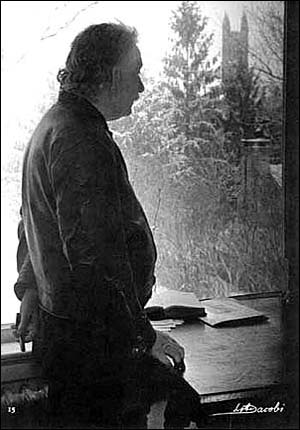
Einstein became a US citizen in 1940 and spent most of his later years trying to develop a theory that unified all of physics including atomic particles. In this he did not succeed. He was somewhat stubborn and a holdout on some of the major discoveries of the 20th century. He poked fun at some of the newer theories by saying that "God does not play dice". He died in 1955 at the age of 76 of a bleeding aortic aneurysm. He was a very humble man in love with physics.
There is a question among modern physicists "Who is the all time top physicist that ever lived?". No question, Isaac Newton and Albert Einstein are off the charts. Its a photo finish, no one else is even close. Most concede it is a virtual tie. Newton's claim is obvious. He created modern physics. His equations were so broad that they described the behavior of phenomenon not only on earth, but of the entire universe. That is mind boggling!
Einstein revised not only Newtonian physics to describe developments 200 years later, but from a purely theoretical basis with no empirical evidence as guidance. He predicted so many brand new concepts that it is hard to even imagine how one could conceptualize such things. Just a few examples: light is built up of photons, the speed of light is a universal constant, energy and mass are convertible into one another, space and time are not fixed, there is no either, gravity and acceleration are basically the same, and so forth. Both men were just phenomenal individuals that not only changed the world of physics, but made a tremendous contribution to the everyday lives of all of us. We give some examples of the consequences of Einstein's advancements below.
Let us not forget James Maxwell, he is considered a solid number three as he consolidated the various theories of elecro-magnetic principles as above. For more information on Albert Einstein's life see Genious Among Geniuses. Top
What is a "red shift"?
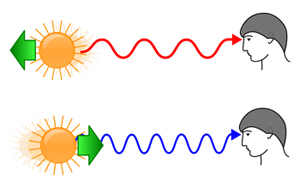
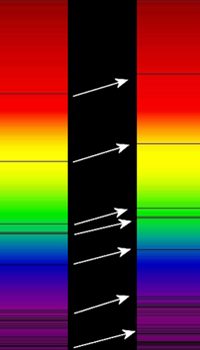
In a phenomenon, called a "Doppler Shift:", the sound wavelength emitted by something moving away from us is shifted to a lower frequency, and the wavelength of something moving towards us is shifted to a higher frequency. See the illustration to the left. A good example of this is the sound of an ambulance siren as it drives by. The pitch of the siren increases as the ambulance moves towards us, and decreases as it moves away. Although this example is for sound waves, the same effect occurs for all electromagnetic wavelengths including light.
The result is that wavelengths emitted by celestial objects moving away from us are shifted towards the red part of the visible spectrum or "red shifted". The faster they move away from us, the more they are red shifted. See the picture to the right of a distant star moving away from us. The right portion is the distant star, the left portion is our sun. Likewise objects that are moving towards us are shifted towards the blue part of the spectrum and are "blue shifted".
As the universe is "expanding", light waves from another galaxy will normally be stretched out to longer wavelengths (just a few galaxies are moving towards us). This is exactly what Hubble observed when he looked at distant galaxies. He saw that their light was "red shifted", and therefore the galaxy clusters were moving away from each other.
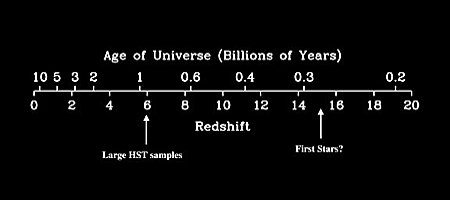
The diagram to the left correlates a redshift reading to the age of the universe. For example, a redshift of 6.0 correlates to the universe being about 950 million years old after the Big Bang. (A redshift of 6.0 is the yardstick that defines the upper boundary of the early universe.) The bottom scale (redshift number) of the chart is linear, while the top scale (age) is non-linear.
At about 200 million years, a redshift of about 19.0, young stars are believed to have started forming. At a redshift of 11 (an age of 420 million years), which is the highest redshift to date ever recorded, galaxies are believed to have started forming. Top
Basic Principles Of Relativity
-
Relativity is reconciling the scientific behavior of two bodies when one of them is moving relative to the other. The absolute velocity of an object cannot be determined by measuring the velocity from a location that is itself moving. Only relative velocity can be measured.
If a body is moving at a constant speed in a straight line (inertial motion), it will observe the same laws of physics that a stationary body observes. Only when accelerating, decelerating or turning does relativity aspects come into play.
-
The speed of light in a vacuum is a universal constant, c, the same for all observers regardless of their relative motion or the motion of the light source. (c = exactly 299,792,458 meters per second, or 186,291 miles/sec, or 670.6 million miles per hour.)
-
Energy and mass are equivalent. Mass can be converted into energy by the equation E = mc2.
Space and time are not static linear items, but are dynamic entities capable of being changed by matter within them and being able to change the way matter within them behaves. Space-time is like a set of curved fabrics in response to the presence of matter.
-
Newtonian physics suggested that gravity was caused by an invisible force between two bodies that attracted one another. In General Relativity there is no invisible force. The presence of mass in space causes the curvature of space-time. Bodies simply follow the path of least resistance in this curved space. Space is not flat and rigid, but is curved around massive bodies.
-
The equivalence principle - it is not possible by experiment to distinguish between the effects caused by the acceleration of a system and those caused by gravity - they are equivalent to each other.
-
In normal life there are only very small actual differences between General Relativity and Newtonian theory. However, all the experimental data have matched the predictions of General Relativity almost exactly. Only when speeds begin to approach the speed of light do the effects of Relativity kick in. Top
Space-Time And Gravity
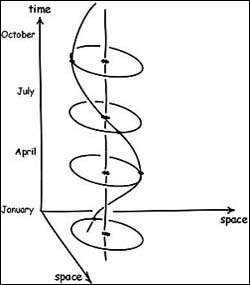
Space-Time. Einstein's Theory of Relativity is based on the notion that in addition to the normal three dimensions of space, there is a fourth dimension - time. Einstein called his four dimensional universe Space-Time. It is not possible to draw something in four dimensions, so it is not easy to visualize Space-Time. The simplified diagram at the left will serve as an introduction. It is two dimensions of space plus one of time. The "vertical line" in the diagram represents a stationary sun. Something that is stationary in three dimensional Space-Time is a vertical line. It does not move in space but as time passes it stays in the same position in space creating a straight line. The 4 circles represent the first day of each quarter as the earth orbits the sun. The line that connects the positions of the earth around the sun as the year progresses forms a "helix". Curved lines are the norm in Space-Time.
Let's look at a real curved space example. Suppose there are two people several hundred miles apart on the equator (position A and B) as shown in the in the diagram at the below left. They both walk directly north in straight lines that are parallel as they start off. As far as each individual is concerned they are walking in a straight line to the north pole. However they are walking in a curved three dimensional space as our earth is not flat. Although as they take each step, they think they are walking straight parallel lines, we can see from their paths on the globe that they converge and eventually cross at the north pole.
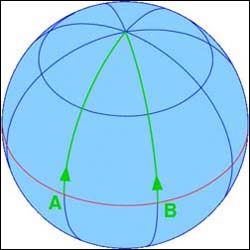
This example illustrates another point. The shortest distance between two points on a globe is not a straight line, but a great circle. Airlines that fly international routes across oceans know this very well and fly great circle routes which are the shortest distance between any two points on a curved surface. In any type of space, the shortest path between two points is called a "geodesic". In a flat space (one with no curvature) geodesics are straight lines. In curved spaces geodesics are more difficult to define. On the surface of a sphere, geodesics do not stay parallel to each other. Such a space, where parallel lines tend to curve inwards towards each other, is said to have "positive curvature".
A space with a large positive curvature, is like the surface of a very small sphere. In general curvature is simply an intrinsic property of a space. In Newtonian physics a body with zero forces acting on it will move in a straight line. In Space-Time what used to be straight lines are now curved, and a body with zero forces acting on it will move in a curved path.
Our brains think in terms of flat dimensions, so it is hard for us to picture a curved space. General Relativity (GR) is really a theory about gravity. As part of the theory, space and time are not linear but are variables dependent on the masses of bodies around them. Space-Time is curved in proportion to the size of the mass of each individual body.
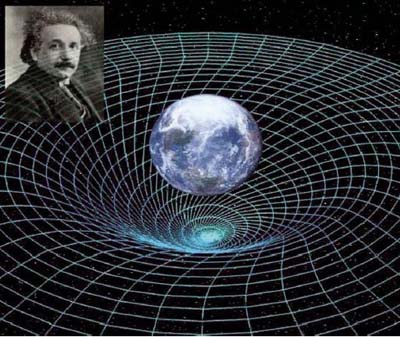
Gravity. Newton's Law of Gravity assumes gravity is a force. Two bodies, like the earth and the moon, exert a pull on each other. The gravitational force between them is proportional to their masses and is inversely proportional to the distance between the centers of the two objects squared. Newton's law of gravity was able to explain in detail not only the orbit of the moon around the earth, but also the motion of the planets around the sun and much more. However, Newton never really explained how gravity worked.
In General Relativity gravity is not a force. A large body like the earth causes the Space-Time around it to curve, and this curvature in turn channels the motion of the moon to follow a curved path around the earth. Remember, a body in motion tends to stay in motion if there are no forces acting on it. So the moon will continue to follow its channel path around the earth indefinitely.
Space-Time is like a curved fabric in response to the presence of matter. See the simplified illustration to the left, which helps one to envision what Space-Time is like. However, the illustration is not exactly right. In fact there are layers and layers of fabric of which only one is shown. And, when you get within a critical distance of a body, say the earth, the Space-Time fabric no longer folds around it, but follows a path directly into the earth. For example, when meteors fall within the earth's atmosphere, "gravity channels" direct them on a path that will eventually cause them to crash into the earth's surface (provided they do not burn up on the way down). For a very good visual explanation of GR gravity, see the Gravity Video from NOVA.
As noted above, space and time are not static linear items, but are dynamic entities capable of being changed by matter within them. The Russian mathematician Hermann Minkowski simplified the method of solving many types of problems in relativity by developing a geometry of four dimensions in which time is related to length, width, and depth. Newton's laws continues to hold in GR, but as a special cases of the more encompassing theory. Top
Confirming Relativity:
The Planet Mercury

When Einstein published General Relativity in 1915, he proposed three tests of the theory. The first test he was able to conduct himself. For about 50 previous years, it was known that there was something unusual about the orbit of Mercury. The elliptical path it carves around the sun shifts with each orbit, leaving its closest point to the sun slightly closer with each pass. Factoring in the gravitational tug of the other planets still left a slight discrepancy that couldn't be accounted for using Newtonian equations. Specifically, the long axis of its ellipse revolves around the sun faster than the Newtonian prediction by one degree every 8,300 years! Einstein tackled the problem using his own equations and calculated the proper displacement exactly. Einstein told a colleague: "The validation of my theory gave me palpitations of my heart. For a few days I was beside myself with joyous excitement" (translated from German). Top
Bending Of Light (Gravitational Lensing)
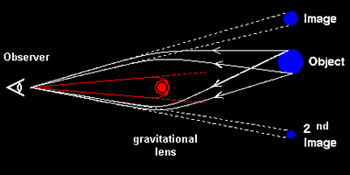
The first of Einstein's gravity predictions that was tested by others in the real world was the bending of light as it passes near a massive body. During the solar eclipse of 1919, when the sun was in front of the Hyades star cluster whose position was well known, Sir Arthur Eddington, a well known English Astronomer, stationed himself on an island off the western coast of Africa and sent another group of British scientists to Brazil. Their measurements of several of the stars in the cluster showed that the light from these stars was indeed bent by the exact amount of Einstein's equations as it passed close by the sun. Einstein became a celebrity overnight when the results were published. The bending of light results from the warping of space in the vicinity of a massive object - in this case the sun. See the chart at the left. The light never changes course, but merely follows the curvature of bent space.
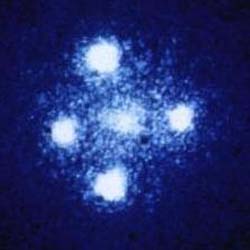
Large bodies of matter cause the space around them to curve. Astronomers now refer to this bending of light as Gravitational Lensing. An example of Gravitational Lensing is the famous Einstein Cross shown at the left. The body in the middle is a galaxy known as Huchra's Lens and is 400 "million" light years from earth. The four bodies surrounding the middle galaxy are not real. Directly behind the galaxy sits a single quasar, Q2237+030, which is 8 "billion" light years - much, much further away. The light from the quasar behind the very large galaxy is bent multiple times by the Gravitational Lens so that it appears there are four quasars, but this is an illusion. There is only one quasar.
This effect was predicted by Einstein's equations and Einstein wrote a famous paper on it in 1936. Again, it confirmed General Relativity and the curvature of space. If the light source, the massive lensing object, and the observer lie in a straight line, the original light source will appear as a ring around the massive lensing body. If there is any misalignment the observer will see an arc segment instead. All of these have now been observed. When the lensing mass is complex, such as a galaxy, the source may resemble partial arcs scattered around the lens or multiple distorted images of the same source.
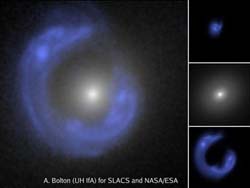
The number and shape of these images depends upon the relative positions of the source, the lens, and the observer plus the exact shape and size of the lensing body. At the left is a photo of a blue Einstein Ring, another example of Gravitational Lensing. In the center of the photo on the left is a large white galaxy. Behind the white galaxy is a very distant blue galaxy (blue galaxies are early stage galaxies). The blue galaxy is depicted in the top right small photo.
Again, the blue light from the distant galaxy is bent around the white galaxy in front of it and forms a partial blue ring as seen from the front. The blue galaxy is also highly magnified. Scientists can study the more distant objects better when they are magnified. Einstein Rings also allow astronomers to determine the mass and dark matter content of the foreground white galaxies. Using the Hubble Telescope and other satellites, scientists have discovered approximately 120 Gravitational Lens galaxies and about 10% have Einstein Rings around them. Top
Time Slows Down In Flight

Relativity specifies that the speed of light is always a constant but space and time are variable. For example, time varies on a clock that is in motion compared to one that is stationary. Physicist J. C. Hafele of Washington University in St. Louis and astronomer Richard Keating of the U.S. Naval Observatory devised a test in 1971 to verify "dilation of time" as this phenomenon is called. In order to obtain extremely accurate measurements, they used atomic clocks - ultra accurate clocks that rely on the "frequency of light waves emitted by cesium atoms". The team flew four cesium clocks aboard two commercial jet flights. One flight went eastward, the other westward, and each included over 40 hours of flight time. Both sets of clocks were compared to atomic clocks at the Naval Observatory on the ground.
The team's premise was this: relative to an master clock that is "stationary," the clock flying eastward, in the direction of the earth's rotation, would be traveling more quickly than would the ground clock, which would be moving with the earth's rotation but otherwise stationary. According to Relativity, the eastward flying clock should run more slowly than the clock on the ground. Hafele and Keating worked out exactly the effects of relativity for both the east-flying and west-flying clocks. Their findings completely validated Einstein's theory. According to their calculations using Relativity, the flying clocks should loose 40 nanoseconds on the eastern flight and gain 275 nanoseconds on the western flight. The actual results - a loss of roughly 59 nanoseconds going east and a gain of around 273 nanoseconds going west - were well within acceptable margins of error. The change in time is very, very miniscule and undetectable under normal circumstances. Steven Hawking says, "You would have to fly around the world four hundred million times to add one second to your life". Top
Energy And Mass
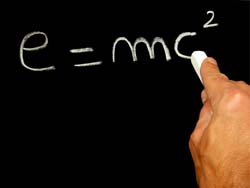
The most famous of all Einstein's equations is E = mc^2, which is energy equals mass times the speed of light squared. This means that energy can be converted into mass and vice versa. They are different forms of the same thing. It also means that a very small amount of mass can be converted into a humongous amount of energy. The constant, c, the speed of light is 186,000 miles per second. The square of c is 34,596,000,000 or 34.6 "billion" miles per hour. A small thing like a walnut has enough potential energy locked within it to power a city. A small mass of uranium can be converted into an atomic bomb or used in a reactor to power an electrical plant.
So why do you have to multiply mass by the square of the speed of light to determine how much energy is bound up inside it? The reason is that whenever you convert a piece of matter into pure energy, the resulting energy is by definition moving at the speed of light. Pure energy is electro-magnetic radiation, whether light or X-rays or whatever, and electro-magnetic radiation travels at a fixed speed of 186,000 miles per second.
In the 1905 paper in which he introduced E = mc2 to the world, Einstein suggested that it would be possible to test his equation using radium, an ounce of which continuously emits 4,000 calories of heat per hour (Marie Curie had discovered this earlier). Einstein believed that radium was constantly converting part of its mass to energy exactly as his equations specified. He was eventually proven right. Today radiocarbon dating, which archeologists use to date ancient materials, is yet another application of his formula. Top
Binary Pulsars
What Is A Pulsar?
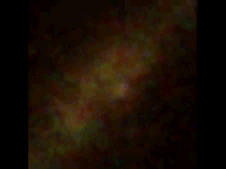
Shown at the left is an actual gamma-ray recording from the Vela Pulsar. The image shows pulsed gamma rays from the Vela Pulsar as recorded by the Fermi Gamma-Ray Space Telescope. A pulsar is formed when the core of a massive dying star is compressed during an end of life supernova explosion which collapses the star into a tiny compact neutron star. The neutron star's gravity is so incredibly strong that electrons are forced into the protons of the atomic nuclei which are then transformed into neutrons. The neutron star has enormous density; it is only about 10 to 15 miles in diameter but weighs as least as much as our sun ( 330,000 times the mass of the earth). The neutron star retains most of its original angular momentum and with a much reduced radius has an extremely high rotational speed. The fastest pulsars spin several hundred revolutions per second. A beam of radiation is emitted along the magnetic axis of the pulsar which normally differs from its rotational axis. The radiation can only be observed when the beam of emission is pointing towards the earth. As the star rotates the radiation sweeps around and around like a lighthouse (called the "lighthouse effect") which characterizes the pulsed nature of the star. The interval between observed pulses is very regular and for some pulsars the pulsation period is as precise as an atomic clock. The observed periods of the star's pulses range from 1.4 milliseconds to 8.5 full seconds. The theory of how pulsars emit their radiation is still in its infancy even after forty years of study. The first pulsar star was discovered by Jocelyn Bell and Anthony Hewish for which Hewish received the Nobel Prize in Physics in 1974.
Binary Pulsars
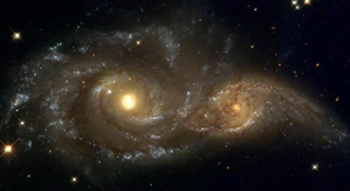
A binary pulsar is a pair of stars consisting of a pulsar and a companion, either a white dwarf or another neutron star, which could also be a second pulsar - as shown in the photo at the left. In 1974 Joseph Taylor and Russell Hulse of the University Of Massachusetts were searching for new pulsars using the huge Arecibo radio telescope in Puerto Rico. When they observed a particular new pulsar, named PSR1913+16, they noticed that the pulse frequency fluctuated. These variations changed in a smooth and repetitive manner, with a period of 7.75 hours, one "pulsar year". They realized that this pattern was an indication that the pulsar was in a tight binary orbit with another star and both were moving at very high velocities. By observing the shift in the pulses, Hulse and Taylor calculated that the stars were equally heavy, each weighing about 1.4 times as much as our sun. Since neither star was visible, they concluded that both bodies must be neutron stars. In 1993 Hulse and Taylor received the Nobel Prize in Physics for their discovery of binary pulsars and their analysis of the pulsar system confirming General Relativity.
Binary Pulsars and General Relativity
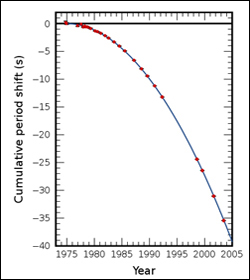
Binary pulsars are one of the few tools scientists have to detect evidence of Gravitational Waves. Einstein’s theory of General Relativity predicts that two stars moving very fast and very close together should emit large amounts of Gravitational Waves. According to Relativity, accelerating masses emit Gravitational Waves which are a traveling deformation of the fabric of space-time. Gravitational Waves should carry away orbital energy and cause the two stars to come closer together. Their orbits should shrink and their orbiting period should shorten. Although the binary companion to a pulsar is "radio quiet", the timing of the pulses from the active pulsar can be measured with extraordinary accuracy using a radio telescope.
The Hulse Taylor binary pulsar (PSR1913+16) has been observed continuously since its discovery. In fact the orbiting period has decreased as predicted by Relativity. Shown in the graph at the left is the blue line which is the period shift calculation using Einstein's theory and equations. The red dots are actual observations of the shift over a 30 year period. The agreement with Relativity Theory is almost perfect, within 0.5%. This is considered by some as the original proof that Gravitational Waves really exist. This is also one of the strongest pieces of evidence for the validity of the General Theory of Relativity. Top
Gravitational Waves
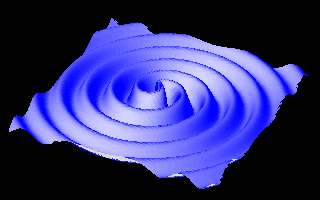
There have been dozens of tests of Relativity and every one of them has confirmed the theory. However, there is one "prediction" that was never "directly" confirmed until late 2015. Einstein's theory predicted that major disturbances in space-time would generate radiation in the form of Gravitational Waves as noted in the binary pulsar section above. The Hulse Taylor analysis "implied" that the lost energy was going into Gravitational Waves. Gravitational Waves are small vibrations, i.e. waves, in the curvature of space-time caused by very large disturbances of matter. Any time there is an accelerating mass, gravitational waves are produced.
Propagating at (or near) the speed of light, Gravitational Waves do not travel "through" space-time as such, the fabric of space-time itself is "oscillating" as in the animation above. Though Gravitational Waves pass straight through matter, their strength weakens in proportion to the distance they travel from the source. A Gravitational Wave arriving on earth will alternately "stretch and shrink distances", but on an incredibly small scale. The Waves are calculated to be one thousandth the diameter of a proton in size.
Detecting Gravitational Waves is a major break through in astronomy. It opens the doors to study the universe using a technology other than light. Eventually there will be quite a few gravitational wave observatories that will significantly add to our knowledge of the universe. Detecting the Waves is much more than just proving Einstein right, it is the exciting opening of a new scientific window to further human understanding of how we got here. Top
LIGO Observatory
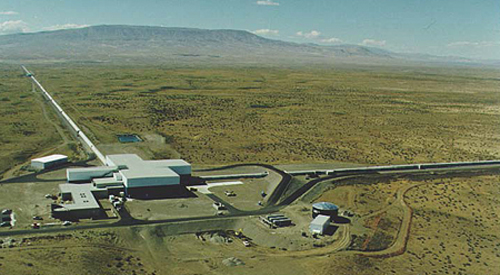
The Laser Interferometer Gravitational-wave Observatory (LIGO) is a large scale physics experiment to directly detect Gravitational Waves. LIGO is a joint project founded in 1992 by Kip Thorne and Ronald Drever of Caltech and Rainer Weiss of MIT. It has been primarily funded by the National Science Foundation (NSF) for all this time. At an initial cost of $365 million, it was the largest and most ambitious project ever funded by the NSF. Up until 2016, NSF spent about $1.1 billion on LIGO over the years while facing down much criticism that the sources of gravitational waves were not plentiful and/or loud enough to justify the huge cost.
LIGO operates two Gravitational Wave Observatories in unison: the LIGO Livingston Observatory in Livingston, Louisiana and the LIGO Hanford Observatory on the Hanford Nuclear Reservation (shown in the picture to the left) in the state of Washington. Each observatory supports an L-shaped ultra high vacuum system measuring precisely 4.0 kilometers (2.5 miles) on each side. The great challenge is to get rid of the many disturbances, like air pressure and temperature fluctuations, as well as seismic vibrations of all sorts, that can distort a signal. A high vacuum system is deployed to prevent vibrations from the surrounding air. More than 1,000 scientists now belong to the LIGO collaboration.
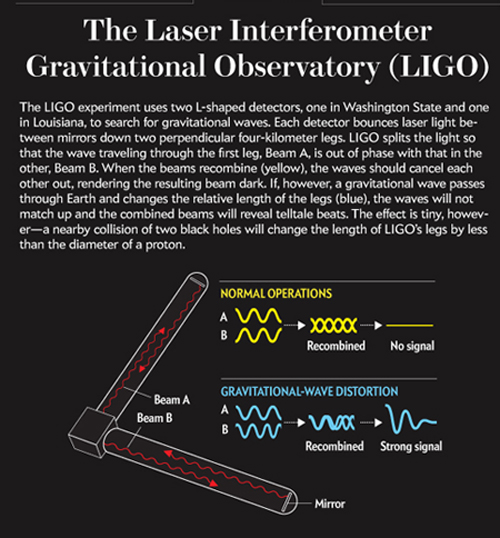
The interferometers at each site consists of mirrors suspended at the corner of the L and at both ends. As shown in the figure at the left, a laser beam is split and sent down both sides of the L with each side being exactly "out of phase" with the other. Under normal operation, when the beams return they cancel each other and no light enters the sensing photo-detector.
If real Gravitational Waves come through, the extremely precise mirrors will shift slightly with one side of the laser tube slightly lengthened and the other tube slightly shortened. Thus when the beams return and are combined, they will be slightly "in phase" forming a light pattern. This pattern will be recorded by a photo-detector and later analyzed. Each half-beam is bounced back and forth 100 times to amplify any discrepancy before the half-beams are recombined. The mirrors will oscillate in and out for as long as the Gravitational Waves are present.
The reason for two separate observatories is that if one is affected by ground noise or any kind of disturbance, the other would not be affected 1,865 miles away. If Gravitational Waves from outer space are present, they are simultaneously detected by both systems, but slightly out of phase due to the distance between the two observatories.
The first version of the observatories, known as "Initial LIGO", began in 2000 mostly to show that it could work on the scale required. Up until 2010 no Gravitational Waves were detected.
LIGO Upgrades. LIGO was upgraded between 2010 and 2015 to improve the facilities’ ability to identify gravitational waves by a factor of 10. Thanks to the $221m upgrade, known as Advanced LIGO (aLIGO), researchers could detect gravitational waves that originated anywhere within a sphere of 420 million light-years of a radius centered on the Earth.
In 2019 the UK, Australia and the US announced a $35m upgrade to the Advanced LIGO system called the Advanced LIGO Plus (aLIGO+). The US National Science Foundation will provide $20.4m for the new upgrade while the UK Research and Innovation agency will provide $14.1m, plus an additional $0.5m from the Australian Research Council. Work on the upgrade will start in 2023 and be complete two years later. The improvements will enable the twin observatories to double their sensitivity to gravitational waves. New coatings will be applied to the mirrors to reduce thermal noise as well as improvements to the laser system. The new aLIGO+’s capabilities are expected to probe the origins of stellar-mass black holes, allow precision tests of extreme gravity, and enable a detailed study of neutron stars.
A good Video of LIGO can be seen here. Top
LIGO Observes Gravitational Waves
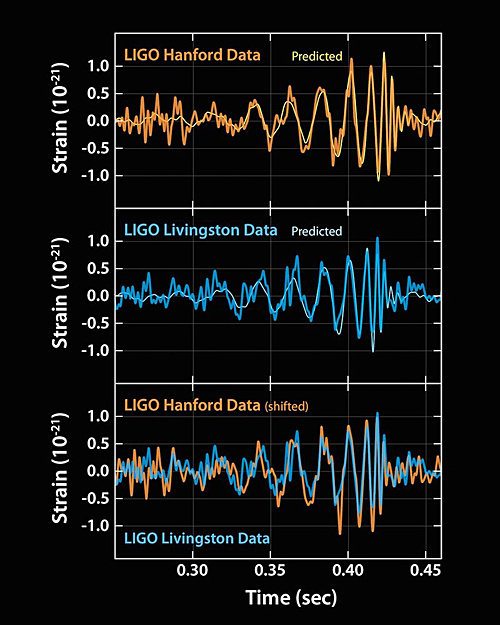
On September 14, 2015, 4:50 a.m. in Louisiana and 2:50 a.m. in Washington, the LIGO system had barely finished being calibrated and was in an engineering run when a loud signal came through at the Livingston site. “Data was streaming, and then - bam,” recalled Dr. David Reitze, the Caltech professor who is the current director of the LIGO Laboratory, the group that built and runs the detectors.
Seven milliseconds later, the signal, now labeled GW150914 (Gravitational Wave year 15, month 9, day 14), hit the Hanford site. LIGO scientists later determined that the likelihood of such identical signals landing almost simultaneously by pure chance was incredibly small. Nobody was awake, but computers recorded the event. Dr. Reitze was on a plane to Louisiana the next day. Dr. Weiss, on vacation in Maine, found out when he checked in by computer that morning. “It was waving hello,” he said. “It was amazing. The signal was so big, I didn't believe it.”
Check out the data charts to the left. The top two plots are from the sites and the bottom one is the two top sites super-imposed. The thin smooth yellow and blue lines in the first two graphs are plots from a computer simulation of two black holes colliding and forming a single larger black hole. The overlap between the real data and the simulation is remarkable.
The oscillation emerged at a frequency of 35 cycles per second (Hz) and increased up to 250 Hz before disappearing just a quarter of a second later. The increasing frequency jives with two massive bodies spiraling into each other. The 7 millisecond delay between the signals in Louisiana and Washington is the right timing for a light-speed wave cruising across the earth and seen on both detectors.
Comparisons with computer simulations reveals that the waves came from two black holes, 29 and 36 times as massive as the sun, starting from about 200 kilometers of each other before merging. As they approached the end at half the speed of light, they were circling each other at an amazing 250 times a second. This LIGO event observation provides the first evidence for black holes themselves that does not depend on hot gas or stars swirling around the holes. (See the real image below of two black holes in the process of merging - NGC 6240.)
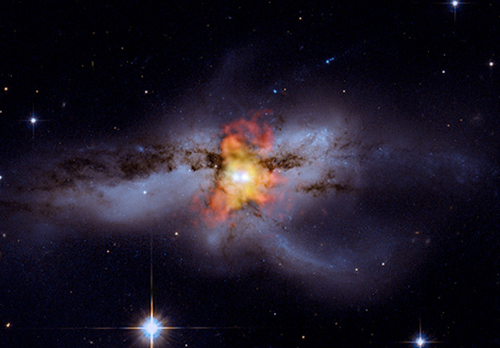
Modeling shows that the final black hole totaled 62 solar masses, 3 solar masses less than the sum of the individual black holes. The missing 3 solar masses vanished in gravitational waves according to Einstein's formula E=mc^2, which is the gravitational radiation that LIGO observed. The signal exceeds the “five-sigma” standard of statistical significance that physicists require to claim a discovery. LIGO researchers reported this event in a paper published in the Physical Review Letters in February, 2016. A very good presentation of the LIGO discovery can be seen at the NSF Announcement.
The most exciting thing about gravitational waves is that we will literally be able to observe the early Big Bang events like "Inflation". Using electromagnetic waves we cannot see further back than 380,000 years after the Big Bang because the early universe was opaque to light. However, it is not opaque to gravitational waves, it is completely transparent. So literally, by analyzing early gravitational waves, we will be able to understand exactly what happened during those initial moments. The great prediction of the Standard Model Theory was that everything came out of a single event - the Big Bang. And now, we will be able to study what really happened. Top
A Kilonova Is "Seen" and "Heard"
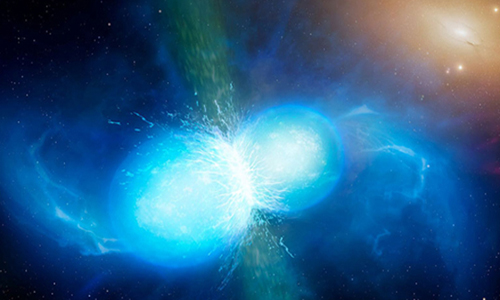
On the morning of August 17, 2017, a ripple in space passed through our planet. It was "heard" by the two LIGO and single Virgo "gravitational" wave detectors. This cosmic disturbance, a kilonova, came from a pair of neutron stars colliding at one third the speed of light. See the NASA artist's conception of the kilonova collision to the left.
When neutron stars slam together, all kinds of things burst out in addition to visible light: gamma rays, x-rays, and radio waves. Transformed into sound, the gravitational signal was a long 100-second chirp, that ended in a sudden whoop up to 1000 cycles per second, two octaves above middle C. This very high frequency indicated that the source was lighter than two black holes colliding.
Meanwhile, the Fermi Gamma Ray Space Telescope, which orbits earth looking for the highest energy radiation in the universe, recorded a brief flash of "gamma rays" just two seconds after the LIGO chirp. Fermi sent out its own alert to astronomers. The gamma ray burst lasted about two seconds, which put it in a category of short gamma ray bursts, which astronomers recognized as two neutron stars colliding.
Learning about the collision from the fast moving gravitational waves, astronomers around the world jumped into action. Telescopes large and small scanned the patch of sky where the gravitational waves came from. The three gravitational wave detectors had been able to triangulate the exact sky position. (Note that the speed of gravitational waves from the theory of relativity is equal to the speed of light in a vacuum,"c". In the theory of relativity, the constant "c" is not exclusively about visible light, it is the highest possible speed for any type of interaction in a vacuum.)
Twelve hours later, visual telescopes caught sight of the kilonova in the galaxy called NGC 4993, about 130 million light years from earth. When it was first identified, the fireball of 8,000-degree gas was about the size of Neptune’s orbit and radiating about 200 million times as much energy as the sun. In Chile, the Gemini telescope swerved its large 26-foot mirror to the kilonova. NASA steered the Hubble to the same location. This was the first time a kilonova was both "heard" by gravitational waves, then quickly located and "seen" by visual telescopes. (It convinced some doubters that gravitational waves were really "real".)
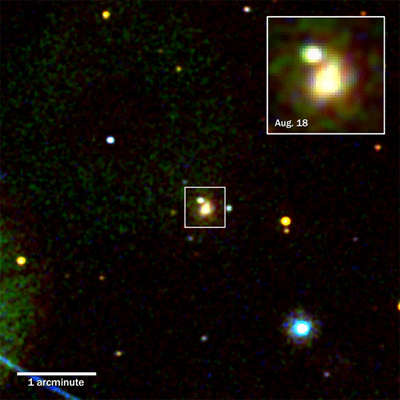
The kilonova was visible in ultraviolet light, as recorded by NASA's Swift telescope. See the actual Swift photo to the left taken on August 18th. The kilonova is the small, white speck immediately above and to the left of the bright galaxy NGC 4993 in the center of the photo. (The upper right insert is a magnified view of the galaxy and the kilonova.)
The Swift ultraviolet and optical telescope imaged the event about 15 hours after other observatories detected the gravitational waves and the gamma ray burst on August 17. Just 12 days later, on August 29, the kilonova faded and became undetectable in ultraviolet light. (The image to the left uses false colors and is based on data from images taken from three ultraviolet filters.)
Within two weeks the visible light faded away, leaving behind a warm infrared glow, which eventually disappeared as well. But in this fading light was encoded the answer to the age old question of how gold and other heavy elements are formed.
Shine sunlight through a prism and you will see our sun’s spectrum – the colors of the rainbow spread from short wavelength blue light to long wavelength red light. This spectrum contains the fingerprints of all the elements that are formed inside the sun. Each element is marked by a unique fingerprint of a line in the sun's spectrum.
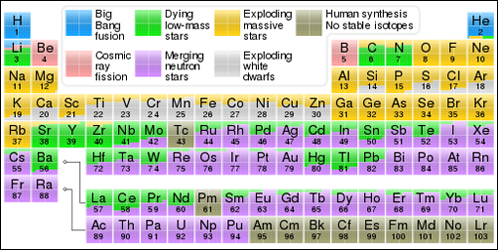
Likewise, the spectrum of a kilonova contains the fingerprints of the heaviest elements in the universe. Its light carries the telltale signature of the neutron-star material decaying into platinum, gold and many other heavy elements. See the periodic table to the left which is color coded by the source of all the elements. Note the large number of "purple" items that result from the collision of two neutron stars - a kilonova.
As of April 2018, there have been six confirmed gravitational wave events announced by the LIGO and Virgo collaborations. However there are, according to Eric Thrane and Rory Smith from the ARC Centre for Gravitational Wave Discovery, more than 100,000 gravitational wave events every year too faint for LIGO and Virgo to unambiguously detect. The gravitational waves from these mergers combine to create a "gravitational wave background". While the individual events that contribute to it cannot be resolved individually, researchers have sought for years to detect this quiet gravitational wave hum.
In a landmark paper in the journal, Physical Review X, the two above researchers have developed a new, more sensitive way of searching for the gravitational wave background. "Measuring the gravitational wave background will allow us to study populations of black holes at vast distances. Someday, the technique may enable us to see gravitational waves from the Big Bang, and those hidden behind gravitational waves from black holes and neutron stars," Thrane said.